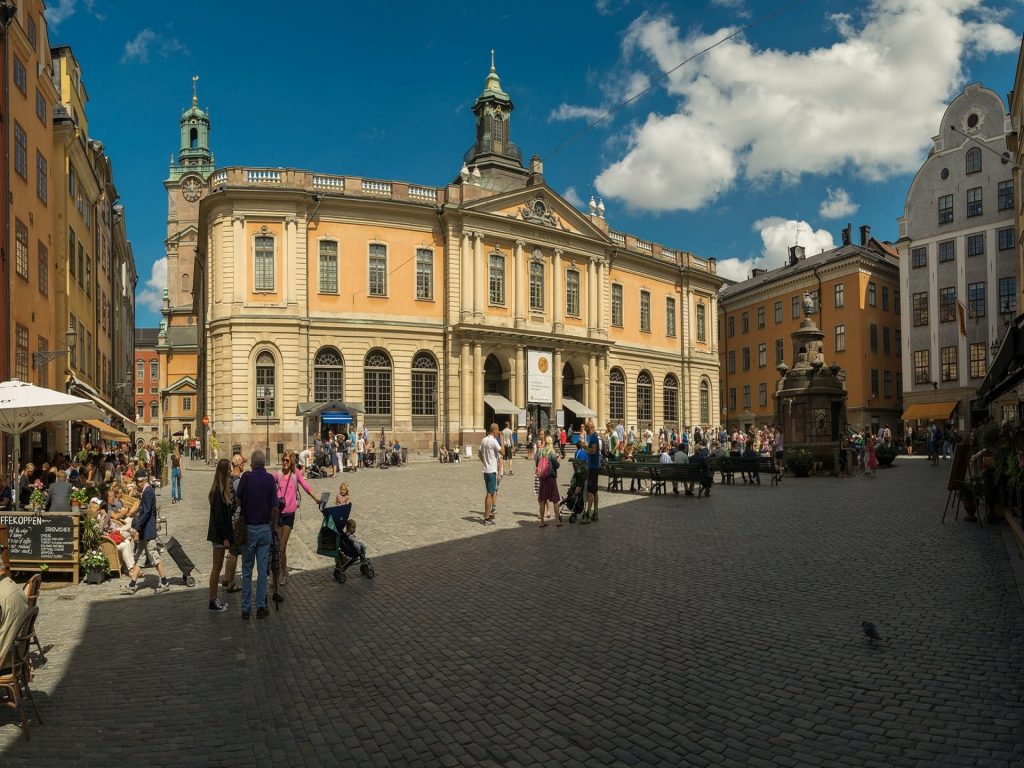
The original ideas man
This is the Nobel Museum in Stockholm, housed in the old Stock Exchange building in the shadow of Storkyrkan‘s baroque steeple. It is right in the heart of the old town – Gamla Stan – and looks out over the cobbles of Stortorget just a short walk up the dappled lanes from Vasterlangaarten. In the bright morning light of Stockholm, it stands still in the quiet of the square, understated with barely a hint of the inspiration within.
As I enter the cool dark hall, there’s a gentle swoosh of past laureates above my head and a series of glowing pillars around the atrium to honour this year’s winners. Come November they will join the parade of banners overhead, their place in the atrium to be subsumed by a new batch of those deemed to have made the most significant difference over the last twelve months.
The original ideas man
Alfred Nobel was born in Sweden in 1833 and had a well-travelled life. He spoke four languages even as a child and throughout his adult life, spent his time most notably in St Petersberg, Stockholm and Paris. He was a descendant of Swedish scientist Olaus Rudbeck and it would appear that invention flowed down the bloodline with Nobel’s father, Immanuel being the inventor of modern plywood and an alumunus of the Royal Swedish Institute of Technology.
Alfred himself had a mind that constantly sought solutions. He had 350 international patents awarded in his lifetime, the most famous of these inventions being dynamite (1867), gelignite (1875) and the predecessor to cordite, ballistite (1887).

(Image credit: Kym Hamer)
A global legacy
Alfred Nobel built an international business empire with interests as far-reaching as Australia, Japan and both North and South America as well as closer to home in Europe and Russia and it lives on in numerous companies world-wide. (Ever heard of chemicals giant Akzo Nobel?) As a result, Nobel left a considerable estate upon his death in 1896.
The Nobel Prize was defined and instructed through Nobel’s last will and testament. His vast fortune was to be held in secure investments and used to fund five prizes each year celebrating…
“…those who, through the preceding year, shall have conferred the greatest benefit upon mankind.”
The five prizes, in areas that held the most fascination and interest for Nobel, were to be awarded by the institutions he held in the greatest esteem. The Nobel Prizes for Physics and Chemistry were to be conferred by The Swedish Academy of Sciences, the Nobel Prize for Physiology or medical works by the Karolinska Institute in Stockholm, the Nobel Prize for Literature by the Swedish Academy and the Nobel Peace Prize by the Norwegian Storting.
However these organisations were unaware of Nobel’s final wishes and it took the creation of the Nobel Foundation and a further five years before the first prize was awarded in 1901. In 1969, a sixth prize was awarded – the Sveriges Riksbank Prize in Economic Sciences in Memory of Alfred Nobel – but while conferred by the Swedish Academy of Sciences at the same ceremony as the other prizes, it is funded by Sweden’s central bank and was not deemed a Nobel prize.
Nobel endeavours
I wander from room to room, watching interviews and footage of just a small number of prize winners. Between 1901 and 2017, 585 prizes have been awarded to 892 laureates who, in leaving their particular legacy, have allowed mankind to continue to shape its future. The soft click overhead heralds the breathy release of a prize winner’s banner on the cableway – each glides noiselessly around the ceiling of the exhibition hall before joining the others again. It’s an ingenious way to make sure that every laureate can be honoured here with plenty of space for those still to come. A video installation, shrouded in diaphanous white folds, explores the future with 19 laureates – what is their hope? – and the importance of passing something on.
Exploring ideas has laid foundation after foundation for the discoveries of today and underpins our society’s progress. It is an awe-inspiring thing – that one man’s passion for ideas and his belief in human creativity lives on in the celebration of those who exemplify his credo in their work, their commitment and in the people who inspire them.
After my visit, I venture to an outdoor cafe to enjoy a coffee and read the small booklet about Alfred Nobel that I’d purchased on my way out. As I finish, I noticed the words on the back cover that lie below the image of the legendary golden medallion:

(Image credit: Kym Hamer)
The Nobel Museum – ideas changing the world
Long may it continue, I think to myself. Long may it continue.





